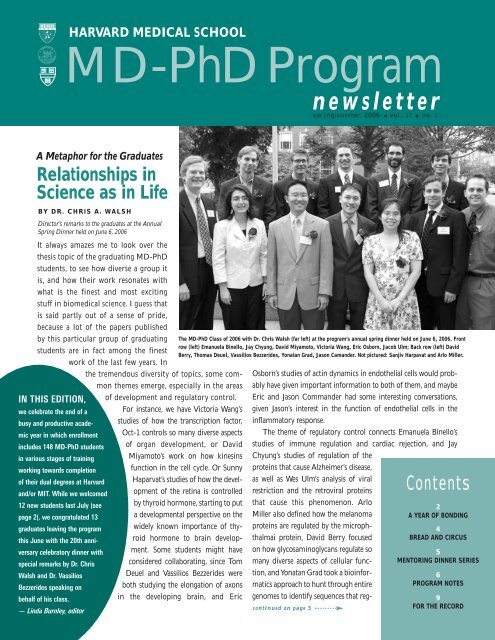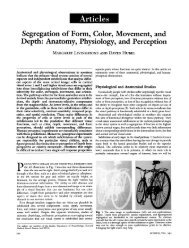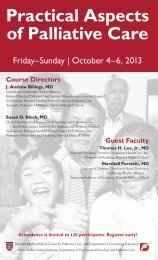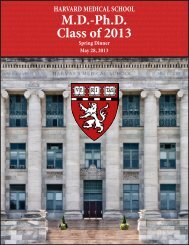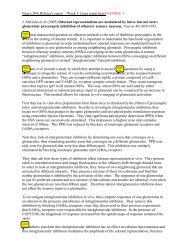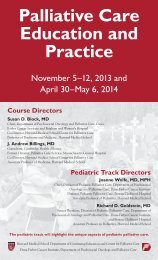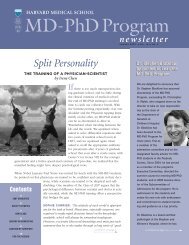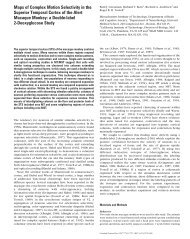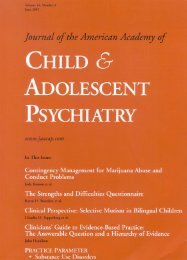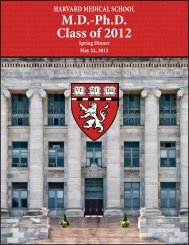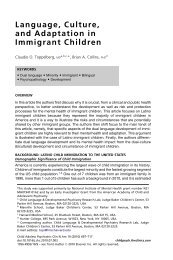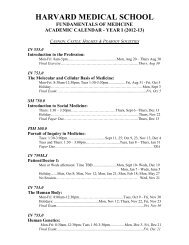MD-PhDProgram - Harvard Medical School - Harvard University
MD-PhDProgram - Harvard Medical School - Harvard University
MD-PhDProgram - Harvard Medical School - Harvard University
Create successful ePaper yourself
Turn your PDF publications into a flip-book with our unique Google optimized e-Paper software.
HARVARD MEDICAL SCHOOL<strong>MD</strong>-<strong>PhDProgram</strong>newsletterspring/summer 2006 ■ vol. 17 ■ no. 1A Metaphor for the GraduatesRelationships inScience as in LifeBY DR. CHRIS A. WALSHDirector’s remarks to the graduates at the AnnualSpring Dinner held on June 6, 2006It always amazes me to look over thethesis topic of the graduating <strong>MD</strong>-PhDstudents, to see how diverse a group itis, and how their work resonates withwhat is the finest and most excitingstuff in biomedical science. I guess thatis said partly out of a sense of pride,because a lot of the papers publishedby this particular group of graduatingstudents are in fact among the finestwork of the last few years. Inthe tremendous diversity of topics, some commonthemes emerge, especially in the areasIN THIS EDITION,we celebrate the end of abusy and productive academicyear in which enrollmentof development and regulatory control.For instance, we have Victoria Wang’sstudies of how the transcription factor,Oct-1 controls so many diverse aspectsincludes 148 <strong>MD</strong>-PhD studentsin various stages of trainingworking towards completionof their dual degrees at <strong>Harvard</strong>and/or MIT. While we welcomed12 new students last July (seepage 2), we congratulated 13graduates leaving the programthis June with the 20th anniversarycelebratory dinner withspecial remarks by Dr. ChrisWalsh and Dr. VassiliosBezzerides speaking onof organ development, or DavidMiyamoto’s work on how kinesinsfunction in the cell cycle. Or SunnyHaparvat’s studies of how the developmentof the retina is controlledby thyroid hormone, starting to puta developmental perspective on thewidely known importance of thyroidhormone to brain development.Some students might haveconsidered collaborating, since TomDeuel and Vassilios Bezzerides wereboth studying the elongation of axonsbehalf of his class.in the developing brain, and Eric— Linda Burnley, editorThe <strong>MD</strong>-PhD Class of 2006 with Dr. Chris Walsh (far left) at the program’s annual spring dinner held on June 6, 2006. Frontrow (left) Emanuela Binello, Jay Chyung, David Miyamoto, Victoria Wang, Eric Osborn, Jacob Ulm; Back row (left) DavidBerry, Thomas Deuel, Vassilios Bezzerides, Yonatan Grad, Jason Camander. Not pictured: Sanjiv Harpavat and Arlo Miller.Osborn’s studies of actin dynamics in endothelial cells would probablyhave given important information to both of them, and maybeEric and Jason Commander had some interesting conversations,given Jason’s interest in the function of endothelial cells in theinflammatory response.The theme of regulatory control connects Emanuela Binello’sstudies of immune regulation and cardiac rejection, and JayChyung’s studies of regulation of theproteins that cause Alzheimer’s disease,as well as Wes Ulm’s analysis of viralrestriction and the retroviral proteinsContentsthat cause this phenomenon. Arlo2Miller also defined how the melanomaA YEAR OF BONDINGproteins are regulated by the microphthalmaiprotein, David Berry focusedBREAD AND CIRCUS4on how glycosaminoglycans regulate so5many diverse aspects of cellular function,and Yonatan Grad took a bioinfor-6MENTORING DINNER SERIESmatics approach to hunt through entirePROGRAM NOTESgenomes to identify sequences that reg-9FOR THE RECORDcontinued on page 5
IN THEIR OWN WORDSA Year of BondingFirst-Year <strong>MD</strong>-PhDs NowReady for Next StepAseemingly disparate group of aspiring scientists and clinicians,this year’s <strong>MD</strong>-PhD class brings with it a variety ofinterests, both academic and extracurricular. From themoment our summer course began, there was excitement allaround. We quickly came together through Sunday night VanderbiltHall potlucks, daytrips around Boston, and late night treks for icecream. In the coming years, we expect this bond to grow strongerand to be a source of support within our group. Despite our variedobsession with the Red Sox or Yankees, 9 pm bedtimes versus midnightMinipreps, and love for warm weather compared to the frigidchills of Boston, our group shares a strong common interest in thepursuit of free food and, of course, a little bit of research if time permits.Below are short descriptions of each of the members of the firstyearclass. These blurbs highlight the diverse backgrounds of thegroup, and the tremendous contribution that such diversity is sureto make in our future development as physician-scientists.Katrina Abuabara, a native of Northern California, stayed true toher roots and graduated from Stanford <strong>University</strong> in 2001 with a BAin human biology and a MA in sociology. She then migrated southto Mexico City, where she worked on reproductive health epidemiologyin Latin America. She has since focused on disease modelingand decision analysis at UCSF and the <strong>Harvard</strong> <strong>School</strong> of PublicHealth, and is currently interested in infectious disease and internationalhealth policy. Even after two years in Boston, she still isn’t convincedthat winter is a time to be indoors, and you may just find herbundled in down, biking along the Charles or jogging in Brookline.<strong>MD</strong>-PhDPROGRAMnewsletterEditorLinda BurnleyAssistant EditorJanelle McCluskeyDesignerKathleen SayrePHOTO CREDITS: LINDA BURNLEY,MOSHE JAKUBOWSKI, LIZA GREENThis newsletter is published twice a yearsince it was first published in 1990.©COPYRIGHT 2006BY THE PRESIDENT AND FELLOWS OFHARVARD COLLEGEwww.hms.harvard.edu/md_phdJoseph Franses was born inWest Lafayette, Indiana, andattended Purdue <strong>University</strong>,where he earned bachelorsdegrees in chemistry and chemicalengineering in 2005. Aftercollege, he married his highschool and college sweetheart,Nicole Waples, before coming toHMS. In his spare time he enjoysplaying on the dominant HSTintramural basketball team,reading, trying to not forget howto play the piano, and findingmore things that need to be fixedin his new condo. Joseph’s pastresearch interests included interfacialchemistry and engineering,organometallic chemistry,and biochemical engineering;his current research interestsErin Loeliger and Marie Hollenhorst at the first Joslin/<strong>MD</strong>-PhD Program postersymposium in August 2005.include cardiovascular drug delivery, biomaterials, and vascularbiology. He hopes to, in chronological order: own a dog, have somekids, and become a cardiologist and researcher. Joseph is very honoredto be part of such a fantastic group of colleagues.Vijay Ganesh was born and raised in upstate New York. As he headedto <strong>Harvard</strong> to pursue a degree in biology, his prescient mothertold him that his good fortunes would follow him to Boston.Unfortunately, this has come to mean that in the six years since heleft his hometown, the N.Y. Yankees and N.Y. Giants have failed towin a single championship, while the historically inept Red Sox andPatriots have experienced unprecedented luck. Perhaps as a testamentto his emotional fortitude, Vijay decided to remain in Bostonfor his <strong>MD</strong>-PhD. He is excited to continue his research training inneuroscience. Though he knows that a career as a physician-scientistis difficult to craft, what he has witnessed in Boston and abroadtells him that anything is possible. This delusion keeps him motivated,and his first-rate classmates in HST keep him happy—bothin class, and on the tennis, basketball, and squash courts.Marie Hollenhorst is from Saratoga, California. She attendedStanford <strong>University</strong>, where she studied biology and did research onthe molecular mechanism of T cell anergy. After graduating, shemade the strange choice to trade Palo Alto’s palm-tree-lined streetsfor the gray skies of Boston. Luckily, in Boston she found a group offriendly and smart <strong>MD</strong>/PhD students who proved to be just crazyenough to merit spending 7-8 years with. In the future, Marie hopesto combine her passions for chemistry, biology, and medicine into asuccessful career that will still allow her to have time for her favoriteactivity: sleeping!Honor Hsin graduated from <strong>Harvard</strong> College in 2005 with a degreein biochemical sciences. She currently aspires to pursue her interestsin molecular neuroscience and forensic psychiatry at MIT and2HARVARD <strong>MD</strong>-PHD PROGRAM newsletter
<strong>Harvard</strong>, respectively. In her spare time sheenjoys running in the gym before class andreading books and articles on foreign affairsand defense policy.Erin Loeliger was raised on the fair shores ofMaryland’s Chesapeake Bay and attendedthe <strong>University</strong> of Maryland BaltimoreCounty, graduating with a major in biochemistryand a minor in philosophy for anice balanced academic diet. During hertime at UMBC, Erin worked in a structuralbiochemistry lab studying viral proteins ofHIV. Her current research interests includevirology and stem cell biology. She spendsher free time pursuing her back-up career ofballroom dancing, pondering the meaningof life and other unanswerable questionsand trying to learn how to cook withoutburning her kitchen down. Erin feelsimmeasurably lucky to be a member of sucha fabulous class.Athar Malik, a native of southeast Michigan,graduated from the Johns Hopkins<strong>University</strong> in 2005 with a degree in biomedicalengineering. Athar’s undergraduateexperiences investigating cartilage tissueengineering excited him about the therapeuticpotential of stem cells and tissue engineering.However, he recently became evenmore excited by the field of neuroscience andis now planning on working in a cellular andmolecular neuroscience laboratory.Motivated principally by his faith as anAhmadi Muslim, Athar hopes to improveunderstanding of normal and pathologicprocesses in the human body through hiscareer as a physician-scientist. As an avidathlete, Athar regularly makes time to playpickup games of basketball and squash withhis colleagues.Peter Miller is a “southern” lad from Atlanta,GA, but has been in Boston for the past fiveyears. As a 2005 graduate of MIT with a dualB.S. in chemical engineering and biology, heis most interested in cancer research,although he has also worked in biochemicalengineering and immunology in the past.Outside of class he enjoys sports, “straightchillin’ and illin’” with colleagues, and loggingonto MyCourses. Other than that, Peterlooks forward to many, many, many years ofeducation and hopes to run a lab, practicepediatric oncology, and cure cancer by theage of thirty four.Sidharth Puram is perhaps the only onewho considers Boston a spring break destination.Born and raised in Minnesota, heviews Boston as a pleasant escape from theoccasional minus-30-degree wind chills ofhis home. As a former MIT student studyingbiology and neuroscience, he worked in thelab of Dr. Bob Langer on DNA delivery usingpolymer microspheres. However, in theupcoming years he hopes to “ditch the engineering,”and pick up some good old-fashionedbiology, a.k.a. droning the days awaywith Western Blots. In his copious amountsof free time, Sid enjoys scuba diving, playingsquash, and participating in photo shootswith his HST colleagues. Although a neurosciencefocused research career is his mostlikely aspiration, he feels confident that if allelse fails, he can fall back on a career of professional“car on frozen lake” driving andsnow football. You’ll know you’ve found himwhen you see the guy without a jacket in thedead of the Boston winter.Xavier Rios-Villanueva used to live inPuerto Rico, where he did his undergradstudies in industrial biotechnology. Heenjoys explaining to people the “special”relationship between Puerto Rico and theUS, and how he is not really an internationalstudent. In addition, he wishes to becomea better salsa dancer and spends a considerableamount of his free time learning aboutthe Japanese culture and language via anime.Currently he is interested in applying systemsbiology approaches to stem cells andhuman metabolism and, as a pastime, wonderswhy people decided to build cities inplaces where winter lasts six months.Takahiro Soda is a son of one of thoseJapanese “salarymen” who thought he wasbeing sent to the USA for 2 or 3 years andwould soon return to Japan and live an averagelife. However, his family ended up stayinghere for a long time. As a result, Takahirograduated from UCLA with a degree in neuroscience.He has taken part in research onHuntington’s disease and is interested in psychiatricillnesses. When Takahiro is not inclass, he is sleeping, playing soccer, or eating,sometimes all at the same time. His drive inlife is to consume mass quantities of goodfood. He somehow plans to achieve this endthrough a career involving research and careof psychiatric illness.From left to right: Katrina Abuabara, Vijay Ganesh, Athar Malik, Marie Hollenhorst, XavierRios, Erin Loeliger, Peter Miller, Honor Hsin, Joseph Franses, Taka Soda, and Sid Puram.HARVARD <strong>MD</strong>-PHD PROGRAM newsletter3
Bread and CircusSome things never changeSince September, the first and second year<strong>MD</strong>-PhD classes have gathered weeklyfor the free exchange of ideas, and, ofcourse, free food. Our goal was to create aforum for informalpeer advising andsocial interaction; theresult was much camaraderieand a fascinatingseries of studentand guest presentations.The topics variedwidely with our diverseinterests, encompassingeverything fromthe conventional to theunconventional, andthen the even less conventional.Craig Mermelbegan the series with an ethical debate on theright of a pharmacist to refuse emergencyThe author, Sol Schulmancontraception. Ben Rapoport later managedto overcome his micrographia long enough topresent an analysis of crossword strategy usingan overhead projector. In October, first yearstudent Peter Miller stepped up to thelunchtable with a truly novel topic: medicine.Using the second years as an overzealous consultservice for the first year class, we collectivelycracked the case “A Five Day Old GirlWith Leukocytosis.”Ben Rapoport set a new standard of entertainmentwith his presentation “Exotic<strong>Medical</strong> Images: Raw Food Diets,” a review ofstrange but true vignettes from the photographicarchives of the New England Journalthat will make you think twice before orderingsushi again.Sol Schulman continued the foray intopseudo-science with a talk on “ExecutivePrivilege: A Matter Of Life And Death,” surveyingthe dark medical secrets of the US presidents.After hearing circumstantial evidencethat our potent leader George ‘The PotomacStallion’ Washington may not have been sopotent, that president Harding likely sufferedfrom mumps orchitis, and that FDR was intodigital clubbing, we successfully completed aquiz matching president with pathology.Dr. Thomas Stossel, Professor of Medicineat <strong>Harvard</strong> <strong>Medical</strong> <strong>School</strong> and the Brighamand Women’s Hospital, engaged us in a livelytalk and subsequent discussion on the relationshipbetween publicly and privately fundedresearch. A strong believer in the benefits offostering a close relationship between academiaand industry, Dr. Stossel highlightedrecent government regulation of such interactionand how we would be impacted as futurephysician-scientists.The weekly lunches also provide a meansby which to implement more formal advising.Distinguished guests have included Dr. Walsh,Dr. Blacklow, Dr. Rupnick, and Dr. Dienstag,collectively covering topics ranging from laband graduate program selection to summerclinical clerkship opportunities.The ancient Romans knew the only trueway to placate an oppressed working class, andsome things never change. Our busy ways pullour classes in many directions, but we continueto look forward each week to our very ownbread and circus.We are happyto introduce theinaugural <strong>MD</strong>-PhDNewsletter cartoonby Ben Rapoport,<strong>MD</strong>-PhD student nowentering his thirdyear in the program.Ben began drawingcartoons for elementaryschool spellingassignments andeventually went onto draw editorialcartoons for the<strong>Harvard</strong> Crimson.4HARVARD <strong>MD</strong>-PHD PROGRAM newsletter
METAPHOR FOR GRADUATEScontinued from page 1ulate all different kinds of genes regardless of theirfunction.And so it seems everything these days in science isabout relationships. How one thing regulates or relatesto another. As though the outer boundary lines of biomedicalscience are becoming sketched in—after all,we know how many base pairs of DNA there are in ourgenome, how many genes there are (approximately),and there are fewer and fewer proteins out there withoutnames or ascribable functions. Genome sequencingprojects are done with the big players humans andmice and are now down to sequencing the nine-toedhedgehog and the armadillo—no kidding—or to figuringout how to sequence your genome or mine, andnot just Craig Ventor’s DNA or the DNA of CraigVentor’s pet dog. This maturity has led some people tosuggest that certain fields—like developmental genetics—arebecoming mature, and that tomorrow’sNature and Cell papers will have to come from somewhereelse. Increasingly this somewhere else involvesworking with a finite group of parts and focusing onhow they relate, because even with a finite number ofelements, we know that their relationships will still bealmost infinite.And I guess that’s a metaphor for where we aretonight. Because even though we are a finite group ofpeople, our relationships are potentially infinite andmuch more interesting: relationships to families, tofriends, to our science, and to the science that is doneby our colleagues. That is where the real interest lies,the “Cell papers of our life-times” not inside ourselvesas one piece, but how we relate. This is something Ifind I have always done a very bad job of rememberingmyself, and that I have been thinking of this week as Iwas at my old school—the <strong>University</strong> of Chicago—helping to celebrate the career of one of my formerteachers, and catching up with some old fellow students.So with that, congratulations, good luck, andmay you have successful relationships.Dr. Walsh is the HMS Bullard Professor of Neurology;Chief of Genetics and Professor of Pediatrics at Children’sHospital; Howard Hughes Investigator at BIDMC; andthe Director of the <strong>MD</strong>-PhD Program since 2003.So, what do you want to bewhen you grow up?BY SARAH E. HENRICKSONMENTORS AND ROLE MODELS are important, as we’vebeen told all our lives. For many of us, that’s how we gothere (and why we wanted to) in the first place. However,as we make our way through the <strong>MD</strong>-PhD Program, it may seemhard to locate role models who are able to maintain a clinical practicewhile successfully pursuing academic research. So, we worked withDr. David Hafler and our program director, Dr. Chris Walsh, to begina series of dinners this past June to help address this issue.The plan was, we could have a small group of <strong>MD</strong>-PhD students intheir lab years of their <strong>MD</strong>-PhD visit the homes of faculty who wouldopen their living rooms and their lives to the students, invite a few facultyfriends, and chat with us over Thai food about how to make thiscareer path work. No powerpoint, no chalk talks—just straightforwardadvice about the things you think about, but are never quite sure whoto ask—how do you move from your residency into a lab of yourown? How do you make time to have kids? How does tenure work?How can you do all this and be happy and fulfilled?So far, we’ve had four dinners. We began in June, 2005, withDr. Chris Walsh and his wife Dr. Ming Hui Chen and their lovelydaughters who invited Dr. Maria Rupnick to join us for Thai food anda discussion of the proposed changes to the medical curriculum atHMS. A few months later, Dr. Hafler and his wife Dr. Janet Hafler, andtheir son Brian, who is a member of the <strong>MD</strong>-PhD Program, and theiryounger son Jason, hosted a dinner in September, inviting us and Dr.Laurie Glimcher, Dr. David Fisher and Dr. Michael Brenner out to WestNewton to enjoy a lovely fall day and conversation. We had a ChineseNew Year-themed dinner with Dr. Cynthia Morton in January, whichled to a great set of discussions about tenure, applying to residency andthe realities of the two academic-track parent families.In April we were hosted by the Provost of <strong>Harvard</strong> <strong>University</strong>, Dr.Steven Hyman and his wife Dr. Barbara Bierer, VP for Research atBWH. It was a great opportunity to chat and get advice from a couplewho both hold key administrative positions. We’re also schedulingdinners with Dr. David Altshuler and Dr. Joel Hirschhorn—if youhave any suggestions for dinners or if you’d like to help out, pleaselet me know!HARVARD <strong>MD</strong>-PHD PROGRAM newsletter5
PROGRAMNotedDr. Alan M. Michelson, <strong>MD</strong>-PhD class of 1986, and member ofthe program’s faculty committees for the past 10 years, has accepteda position as Associate Director for Basic Research at the NationalHeart, Lung and Blood Institute. In this capacity, Dr. Michelson willwork with the NHLBI Director, Dr. Elizabeth Nabel, on extramuralbasic science policy and the development of new research initiatives.Dr. Michelson will also continue his own laboratory research as aSenior Investigator in the NHLBI Division of Intramural Research.Dr. Chris Walsh recognized Dr. Michelson’s role in the Program—citing his outstanding contributions as chair of the Committee ofAdvisors and member of the Executive Committee andSubcommittee on Admissions—with a plaque presented to him atthe program’s dinner in honor of the graduates on June 6, 2006.Parenthetically, Dr. Michelson was one of 8 graduates of the programhonored at the program’s first annual graduation dinner 20years ago in 1986.✓✓In the fall of 2004, the Executive Council of the AAMC approved aproposal to establish a new <strong>MD</strong>-PhD Section of the GraduateResearch Education and Training (GREAT) Group. Membershipin this body includes the faculty who serve as the institutional leadersof <strong>MD</strong>-PhD programs (MSTP and others) at medical schools.The mission of the <strong>MD</strong>-PhD Section is to advance the education,training and career development of physician-scientists, with anemphasis on training in the <strong>MD</strong>-PhD programs of LCME accreditedmedical schools. Both Dr. Chris Walsh and Ms. Linda Burnley aremembers of the new <strong>MD</strong>-PhD Section with Linda serving as afounding member of the <strong>MD</strong>-PhD Section’s Executive Committee aswell as co-chair of the data analysis committee.✓<strong>MD</strong>-PhD Alumnus Dr. Robert L. Satcher, Jr. (MIT ’93), (HMS ’94)gave the Robert H. Ebert Lecture “From <strong>Harvard</strong> to NASA: An AlumniPerspective on Space, Medicine, and Astronauts” on April 28, 2006 aspart of the Alliance Revisitation Weekend events. Dr. Satcher was selectedby NASA in May 2004 and completed Astronaut Candidate Trainingthis past February as part of preparation for futureflight assignments as a mission specialist. Priorto NASA training, he was Assistant Professor atthe Feinberg <strong>School</strong> of Medicine, Northwestern<strong>University</strong>, in Orthopaedic Surgery where he alsoheld appointments as an Attending Physician atChildren’s Memorial Hospital in Chicago specializingin musculoskeletal oncology and an adjunctappointment in the biomedical engineeringdepartment at Northwestern <strong>University</strong>.Program Submits 5-Year Competitive Renewal to NIHThe <strong>Harvard</strong> <strong>MD</strong>-PhD Program submitted its five-year competitiverenewal of its training grant to the NIH last January.The grant was composed of 1,531 pages containing a comprehensivereport on the program’s progress over the past five years, including supportingdata for the $17.1M budgetrequest. Carefully detailed data tablesand analysis of the program’s administration,finances, faculty, alumni, currentstudents and applicant pools supportedthe program’s request.The program faculty and staffworked for over two months to completethe project. While the number ofMSTP trainee positions in the currentThe finished grant before itwas shipped to the NIH.grant is 44, the program director, Dr. Chris A. Walsh, felt strongly that thegrant justified a budget increase to 50 trainee slots. Review of the grantwas held at the NIH on June 20, 2006 and a council decision is anticipatedin October. The funding requested for the next five-year period isanticipated to begin on July 1, 2007.The Days of Molecular Medicine Conferencethis past May in Stockholm, Sweden focused on ChronicInflammation. Marlys Fassett and Sarah Henrickson (below)both fourth years in the program, traveled across the Atlanticto hear great lectures, including those from HMS professorsLaurie Glimcher and Diane Mathis, and chat with colleagues overposters from across the world. The conference showcased fantasticscience, from basic mechanisms of NFkB and innate immunity to the clinical trials for therapiesfor rheumatoid arthritis andother autoimmune disorders. Apanel on the regulatory challengesin the US and Europe for newdrugs generated spirited discussion,as did the banquet at theVasa Museum, home to a 17thcentury Swedish ship that made itless than half an hour out of theharbor on its maiden voyagebefore sinking, only to be resurrectedin the 1950s fromStockholm Harbor. A wonderfultrip! Next year, the DMM conferencewill be at MGH and willfocus on Emerging Technologyand Human Disease.6HARVARD <strong>MD</strong>-PHD PROGRAM newsletter
notesAnnual <strong>MD</strong>-PhD Programand Joslin DiabetesPoster SymposiumLast August, Dr. Joel Hirschhorn,assistant professor of pediatricsand genetics, associate director ofgraduate education, collaboratedwith Dr. Diane J. Mathis, professorof medicine at Joslin DiabetesCenter, to co-sponsor the firstannual <strong>MD</strong>-PhD Poster Symposium for the first and second yearstudents to present research done during their summer labs. Other<strong>MD</strong>-PhD and summer undergraduate students on campus wereinvited to attend, as were investigators at the Joslin, who describedresearch opportunities in their labs. There was a great turnout and avery enthusiastic response to this initial event. We look forward tothe 2nd annual poster session to be held on August 3, 2006.Annual RetreatThe program’s 23rd annual weekend student/facultyretreat was held last October, 2005 atWaterville Valley, NH. Over 100 participantsattended the retreat in which Gary Nabel, <strong>MD</strong>,PhD (left) delivered the 6th Annual Eva NeerMemorial Lecture: “When Bad Viruses Kill GoodCells: From Mechanisms to Prevention.” Dr.Nabel, a 1982 graduate of the <strong>MD</strong>-<strong>PhDProgram</strong>, is Director of the Vaccine ResearchCenter in the National Institute of allergy and Infectious Diseases atNIH. He is well known as a molecular virologist and immunologistfor his work in the fields of HIV, Ebola virus, and cancer research.Several senior students (Anna Farago, John Hanna, Christina Mills,Cullen Taniguchi, Ram Srinivasan, Junne Kamihara, Phillip Erwin,Ashutosh Jadhav) gave oral presentations of their thesis research. Ajoint poster session highlighted research results from 25 differentlabs followed by a special guest lecture by Elizabeth G. Nabel, <strong>MD</strong>,Director of National Heart, Lung, and Blood Institute on “GenomicMedicine and Cardiovascular Disease.” Retreat sponsors included byMerck Research Laboratories, Chiron BioPharmaceuticals, Pfizer,Inc, Abbott Laboratories, Genzyme Corporation, the NIH-MSTPgrant, and <strong>Harvard</strong> <strong>Medical</strong> <strong>School</strong>.The program is now planning the next retreat to be heldOctober 13-15, 2006 at Waterville Valley. Cancer research pioneerDr. M. Judah Folkman, Julia Dyckman Andrus Professor ofPediatric Surgery, has accepted our invitation to give the Eva NeerMemorial Lecture. Save the date!Awards and HonorsAmma Agymang, Phillip Erwin, and Carlos Ponce each receivedindividual Ruth L. Kirschstein National Research Services Awardssponsored by the National Institutues of Health following submissionof individual fellowship applications.Hannah Chang was awarded the Ashford Fellowship as <strong>MD</strong>-PhDgraduate student in the Biophysics Program.Marlys Fassett and Sarah Henrickson were awarded travelfellowships to present abstracts at the Days of Molecular MedicineConference "Inflammation in Chronic Disease" sponsored byMassachusetts General Hospital, Karolinska Institutet and NatureMedicine May 24-27, 2006, Stockholm, Sweden.Sarah Henrickson received Outstanding Poster Award last fall at theCBR Institute for Biomedical Research Annual Retreat. Sarah also wasselected to present a plenary lecture at HMS <strong>Medical</strong> Education Daylast fall; promoted to “Instructor-G” status as teaching assistant.Todd Herrington now finishing his thesis in the lab of John Assadwas named as a recipient of the Stuart H.Q. and Victoria QuanFellowship, an intra-<strong>Harvard</strong> fellowship for neuroscience graduatestudents.The first recipient of this <strong>Harvard</strong> Stem Cell Institute’s <strong>Medical</strong>Scientist Training Fellowship is Ashutosh Jadhav, whose thesiswork has been carried out in the lab of Professor Constance Cepkowhere he has been studying the development of the mammalianretina. The title of his thesis is “Regulation of vertebrate retinaldevelopment by the Notch signaling pathway.”Ryan Lanning was awarded the Department of Defense Breast CancerResearch Program 2005 Predoctoral Traineeship Award. He was alsonamed an Athinoula A. Martinos Research Scholar for biomedicalimaging in 2005.Arindel Maharaj was named an Albert J. Ryan Fellow in November,2005 and was awarded a European Commission travel award to attendthe Euroconference on Angiogenesis in France in May 2006.Christina Mills received the Keystone Symposia scholarship ($1000to help defray travel and lodging expenses associated with attendance)for the Advances in Influenza Research: From Birds to Bench toBedside conference held March 28 - April 2, 2006.Benjamin Rapoport has been awarded the Hugh Hampton YoungMemorial Fellowship, a competitive graduate fellowship at MIT.Sashank Reddy won a CUE teaching award last fall. The awardrecognized his work as a TF for Chem285 taught at <strong>Harvard</strong>.Benjamin Sommers won the annual Academy Health DissertationAward. The Dissertation Award honors an outstanding scientific contributionfrom a doctoral thesis in health services research and the candidateshowing exceptional promise as a health services researcher. Thisyear's dissertation award will be featured in a special session at theAnnual Research Meeting on Tuesday, June 25, 2006.HARVARD <strong>MD</strong>-PHD PROGRAM newsletter7
PROGRAM notesCONTINUED FROM PAGE 7Newest Class for 2006-07The <strong>MD</strong>-PhD Program received 477 applications (63% men;37% women) from undergraduates applying for admissionand funding from the MSTP grant. About 17% were invitedfor competitive interviews for MSTP funding offers. The newMSTP class includes: Mr. Jonathan Abraham (<strong>Harvard</strong>), Ms.Milena Andzelm (<strong>Harvard</strong>), Ms. Erin Chen (U-Chicago), Mr.Mark Lee (Yale), Ms. Devarati Mitra (Stanford), Mr. Yin Ren(MIT), Mr. Cameron Sadegh (MIT); and Ms. Yawei Yang(UCLA); and 2 deferrals from 2005 applicant pool: Ms. SarahHill (<strong>Harvard</strong>) and Ms. Karolina Maciag (<strong>Harvard</strong>); Mr.David Konieczkowski (Princeton) deferred until 2007.GalleryIn August, Ms. Amy Saltzman (Princeton), also a deferralfrom 2005, will join the program in the social sciences trackalong with Mr. Stephen Huffaker (U-Wisconsin), a recipientof the new NIH-Graduate Partners Program. The programalso welcomed Ms. Aurore Halkovich and Mr. Xavier Moisset,visiting French <strong>MD</strong>-PhD students sponsored by INSERM,who are participating in the summer course.Above: Students gatherat the annual summerbarbeque in 2005 onHMS Quad.Spring Dinner on June 6 honored the<strong>MD</strong>-PhD Class of 2006 and brought together,pictured from top:• Drs. Alan Michelson, Yonatan Grad, andMs. Linda Burnley• Dr. Vassilous Bezzerides, center, gave remarkson behalf of his graduating class. Shown withhim are his parents, Bandel and ElizabethBezzerides, and his wife, Ann Mitsakos.• Graduate Thomas Deuel shown here withhis mother Dr. Ruthmary K. Deuel.• Getting together at the Spring Dinner.Left: Jason Comanderat the Match Day onMarch 23, 2006.8HARVARD <strong>MD</strong>-PHD PROGRAM newsletter
For the RecordPhDs CompletedAndrew J. Aguirre, Health Sciences and Technology, BBS-Genetics (DMS) at <strong>Harvard</strong> <strong>University</strong>. [Ronald A. Depinho,M.D.] Genetic Determinants of Pancreatic Ductal Adenocarcinoma (9/05).Siraj M. Ali, Health Sciences and Technology, Biophysics (GSAS) at <strong>Harvard</strong> <strong>University</strong>. [David Sabatini, M.D., Ph.D.] ATale of Two mTor Complexes (6/05).Zarine R. Balsara, Health Sciences and Technology, Immunology (DMS) at <strong>Harvard</strong> <strong>University</strong>. [Michael N. Starnbach,Ph.D.] The interaction of Chlamydia trachomatis with mammalian host cells (5/06).Jakob Begun, Health Sciences and Technology, BBS Microbiology and Molecular Genetics (DMS) at <strong>Harvard</strong> <strong>University</strong>.[Frederick M. Ausubel, Ph.D.] Investigating the host-pathogen interaction using a Staphylococcus-Caenorhabditis elegansmodel system (5/05).Irene A. Chen, Health Sciences and Technology, Biophysics (GSAS) at <strong>Harvard</strong> <strong>University</strong>. [Jack W. Szostak, Ph.D.]Building a Protocell: Physical Aspects and Emergent Behaviors (9/05).Savita V. Dandapani, Castle, BBS-Cell and Developmental Biology (DMS) at <strong>Harvard</strong> <strong>University</strong>. [Martin R. Pollak, M.D.]Role of alpha-actinin-4 in the kidney (7/06).John P. Dekker, Cannon, Neuroscience (DMS) at <strong>Harvard</strong> <strong>University</strong>. [Gary I. Yellen, Ph.D.] Molecular Analysis of Gatingin Voltage - Dependent Ion Channels (5/06).Phillip A. Erwin, Cannon, BBS-Cell and Developmental Biology (DMS) at <strong>Harvard</strong> <strong>University</strong>. [Thomas Michel, M.D.,Ph.D.] Dynamic S-Nitrosylation of Endothelial Nitric Oxide Synthase in Vascular Endothelial Cells (9/05).Anna F. Farago, Castle, BBS-Microbiology and Molecular Genetics (DMS) at <strong>Harvard</strong> <strong>University</strong>. [Susan Dymecki, M.D.,Ph.D.] Uncovering Molecular and Spatial Predictors of Brainstem Identity (6/06).John R. Greenland, HST, Virology (DMS) at <strong>Harvard</strong> <strong>University</strong>. [Norman Letvin, M.D.] Vaccine antigen expression andimmune responses (6/06).Robert S. Griffin, Health Sciences and Technology, Neuroscience (DMS) at <strong>Harvard</strong> <strong>University</strong>. [Clifford Woolf, Ph.D.]Gene expression associated with neuropathic pain (9/05).Robert S. Hagan, Health Sciences and Technology, Biology at MIT. [Peter Sorger, Ph.D.] Regulation of the SpindleCheckpoint by Mad2 Binding Proteins (7/05).David H. Jung, Castle, BBS-Genetics (DMS) at <strong>Harvard</strong> <strong>University</strong>. [Frederick W. Alt, Ph.D.] Cis-acting elements controllingantigen receptor gene assembly (6/05).Junne Kamihara, Health Sciences and Technology, Biology at MIT. [David E. Houseman, Ph.D.] Studies at theHemochromatosis (HFE) Locus: Gene conversions, Haplotypes, and an Association Analysis (12/05).Rita Khodosh, Health Sciences and Technology, Biology at MIT. [Paul A. Garrity, Ph.D.] Beach1 Functionally AntagonizesRab11 During Development and in Regulating Synaptic Morphology (7/05).Christina E. Mills, Health Sciences and Technology, Infectious Disease at <strong>Harvard</strong> <strong>School</strong> of Public Health. [MarcLipsitch, D.Phil] Transmission and Control of Pandemic Influenza (3/06).Bradley J. Molyneaux, Cannon, Neuroscience (DMS) at <strong>Harvard</strong> <strong>University</strong>. [Jeffrey D. Macklis, M.D.] MolecularDevelopment of Corticospinal Motor Neurons (9/05).Carlos F. Paz, Cannon, BBS-Cell and Developmental Biology (DMS) at <strong>Harvard</strong> <strong>University</strong> [Charles J. Wietz, M.D.,Ph.D.] Circadian Clock Function in the Mammalian Retina (10/05).Robert S. Ohgami, Health Sciences and Technology, BBS- Cell and Developmental Biology (DMS) at <strong>Harvard</strong> <strong>University</strong>.[Mark D. Fleming, M.D., D. Phil] Identification and characterization of the Steap family of metalloreductases (5/06).James Rhee, Health Sciences and Technology, BBS-Genetics (DMS) at <strong>Harvard</strong> <strong>University</strong> [Bruce M. Spiegelman,Ph.D.] Partnership of HNF4a with the transcriptional coactivator PGC-1a in the regulation of hepatic glucose and lipidhomeostasis (9/05).Douglas Rubinson, Health Sciences and Technology, Biology at MIT. [Frank B. Gertler, Ph.D.] Knocked Down andKnocked Out: A lentiviral system for RNAi transgenesis and the Ena/VASP triple-knockout uncovers functions inmouse development (5/05).Safa A. Sadeghpour, Health Sciences and Technology, Brain & Cognitive Sciences at MIT. [Guosong Liu, M.D., Ph.D.]N<strong>MD</strong>A Normalization in Hippocampal Neurons: Activity-Dependent, Temporal, and Spatial Properties (8/05).Patrick Safo, Cannon, Neuroscience (DMS) at <strong>Harvard</strong> <strong>University</strong>. [Wade G. Regehr, Ph.D.] The Role ofEndocannabinoids in Synaptic Plasticity as the Granule Cell to Purkinje Cell Synapse (6/06).Jay A. Shendure, Peabody, BBS-Genetics (DMS) at <strong>Harvard</strong> <strong>University</strong> [George M. Church, Ph.D.] Multiplex GenomeSequencing and Analysis (8/05).Bryan K-H. Sun, Holmes, BBS-Genetics (DMS) at <strong>Harvard</strong> <strong>University</strong>. [Jeannie T. Lee, M.D., Ph.D.] Mechanisms of Tsixmediatedrepression of Xist (4/06).David Y. Takeda, Health Sciences and Technology, Pathology (DMS) at <strong>Harvard</strong> <strong>University</strong>. [Anindya Dutta, Ph.D.]Regulation of Mammalian Replication Initiators During the Cell Cycle (6/05).Cullen M. Taniguchi, Castle, BBS-Cell and Developmental Biology (DMS) at <strong>Harvard</strong> <strong>University</strong> [C. Ronald Kahn, M.D.,D.Sc.] The Dissection of Insulin Signaling Isoforms In Vivo: Molecular Mechanisms of Hepatic Insulin Action (11/05).Vesselin T. Tomov, Health Sciences and Technology, BBS-Genetics (DMS) at <strong>Harvard</strong> <strong>University</strong>. [Brian Seed, Ph.D.]Codon-Optimized and Reporter-Packaging Strains of HIV-1 (6/06).Griffin M. Weber, Health Sciences and Technology, Engineering & Applied Sciences (GSAS) at <strong>Harvard</strong> <strong>University</strong>. [LucilaOhno-Machado, M.D., Ph.D.] Data representation and algorithms for biomedical informatics applications (5/05).Ernest N. Yeh, Health Sciences and Technology, Electrical Engineering and Computer Science at MIT. [Daniel K.Sodickson, M.D., Ph.D.] Advanced Image Reconstruction in Parallel Magnetic Resonance Imaging: Constraints andSolutions (5/05).Glenn C-W. Yiu, Health Sciences and Technology, Neuroscience (DMS) at <strong>Harvard</strong> <strong>University</strong>. [Zhigang He, Ph.D.,B.M.] Signaling Mechanisms Limiting Axon Regeneration in the Adult Central Nervous System (5/06).GSAS = Graduate <strong>School</strong> of Arts and Sciences BBS = Biological and Biomedical Sciences DMS = Division of <strong>Medical</strong> SciencesNew PublicationsGrossman D, Ellertson C, Abuabara K, Blanchard K, Rivas FT. Do Product Labeling and PracticeGuidelines Deter Contraceptive Use? Am J Public Health. 2006 Jan 31Tonon G, Wong KK, Maulik G, Brennan C, Feng B, Zhang Y, Khatry DB, Protopopov A, You MJ,Aguirre AJ, Martin ES, Yang Z, Ji H, Chin L, Depinho RA. High-resolution genomic profiles ofhuman lung cancer. Proc Natl Acad Sci U S A. 2005 Jul 5;102(27):9625-30.Dougan SK, Salas A, Rava P, Agyemang A, Kaser A, Morrison J, Khurana A, Kronenberg M, JohnsonC, Exley M, Hussain MM, Blumberg RS. Microsomal triglyceride transfer protein lipidation and controlof CD1d on antigen-presenting cells. J Exp Med. 2005 Aug 15;202(4):529-39.Sarbassov dos D, Ali SM, Sengupta S, Sheen JH, Hsu PP, Bagley AF, Markhard AL, Sabatini DM. ProlongedRapamycin Treatment Inhibits mTORC2 Assembly and Akt/PKB. Mol Cell. 2006 Apr 21;22(2):159-68.Bailey SN, Ali SM, Carpenter AE, Higgins CO, Sabatini DM. Microarrays of lentiviruses for genefunction screens in immortalized and primary cells. Nat Methods. 2006 Feb;3(2):117-22.Sarbassov dos D, Ali SM, Sabatini DM. Growing roles for the mTOR pathway. Curr Opin Cell Biol.2005 Dec;17(6):596-603. Epub 2005 Oct 13. Review.Ali SM, Sabatini DM. Structure of S6K1 determines if raptor-mTOR or rictor-mTOR phosphorylatesits hydrophobic motif site. J Biol Chem. 2005 Apr 4.Lee LA, Lee E, Anderson MA, Vardy L, Tahinci E, Ali SM, Kashevsky H, Benasutti M, Kirschner MW,Orr-Weaver TL. Drosophila genome-scale screen for PAN GU kinase substrates identifies Mat89Bbas a cell cycle regulator. Dev Cell. 2005 Mar;8(3):435-42.Dulay MT, Baca QJ, Zare RN. Enhanced proteolytic activity of covalently bound enzymes in photopolymerizedsol gel. Anal Chem. 2005 Jul 15;77(14):4604-10.O'Hara FP, Beck E, Barr LK, Wong LL, Kessler DS, Riddle RD. Zebrafish Lmx1b.1 and Lmx1b.2 arerequired for maintenance of the isthmic organizer. Development. 2005 Jul;132(14):3163-73.Bernstein-Hanley I, Balsara ZR, Ulmer W, Coers J, Starnbach MN, Dietrich WF. Genetic analysis ofsusceptibility to Chlamydia trachomatis in mouse. Genes Immun. 2006 Jan 5.Sifri CD, Begun J, Ausubel FM. The worm has turned—microbial virulence modeled inCaenorhabditis elegans. Trends Microbiol. 2005 Mar;13(3):119-27. Review.Berry D, Ren J, Kwan CP, Sietsma DK, Sasisekharan R, Finklestein SP. Dimeric fibroblast growth factor-2enhances functional recovery after focal cerebral ischemia. Restor Neurol Neurosci. 2005;23(3-4):251-6.Iyengar P, Espina V, Williams TW, Lin Y, Berry D, Jelicks LA, Lee H, Temple K, Graves R, Pollard J,Chopra N, Russell RG, Sasisekharan R, Trock BJ, Lippman M, Calvert VS, Petricoin EF 3rd, Liotta L,Dadachova E, Pestell RG, Lisanti MP, Bonaldo P, Scherer PE.Adipocyte-derived collagen VI affectsearly mammary tumor progression in vivo, demonstrating a critical interaction in the tumor/stromamicroenvironment. J Clin Invest. 2005 May;115(5):1163-76.Carthon BC, Neumann CA, Das M, Pawlyk B, Li T, Geng Y, Sicinski P. Genetic replacement of cyclinD1 function in mouse development by cyclin D2. Mol Cell Biol. 2005 Feb;25(3):1081-8.Chang HH, Oh PY, Ingber DE, Huang S. Multistable and multistep dynamics in neutrophil differentiation.BMC Cell Biol. 2006 Feb 28;7(1):11Ohki K, Chung S, Ch'ng YH, Kara P, Reid RC. Functional imaging with cellular resolution revealsprecise micro-architecture in visual cortex. Nature. 2005 Feb 10;433(7026):597-603.Fujikawa SM, Chen IA, Szostak JW. Shrink-wrap vesicles. Langmuir. 2005 Dec 20;21(26):12124-9.Chen IA, Salehi-Ashtiani K, Szostak JW. RNA catalysis in model protocell vesicles. J Am Chem Soc.2005 Sep 28;127(38):13213-9.Vining MS, Bradley PL, Comeaux CA, Andrew DJ. Organ positioning in Drosophila requires complextissue-tissue interactions. Dev Biol. 2005 Nov 1;287(1):19-34. Epub 2005 Sep 19.Deuel TA, Liu JS, Corbo JC, Yoo SY, Rorke-Adams LB, Walsh CA. Genetic interactions between doublecortinand doublecortin-like kinase in neuronal migration and axon outgrowth. Neuron. 2006 Jan5;49(1):41-53.Erwin PA, Mitchell DA, Sartoretto J, Marletta MA, Michel T. Subcellular targeting and differential S-nitrosylation of endothelial nitric-oxide synthase. J Biol Chem. 2006 Jan 6;281(1):151-7.Erwin PA, Lin AJ, Golan DE, Michel T. Receptor-regulated dynamic S-nitrosylation of endothelialnitric-oxide synthase in vascular endothelial cells. J Biol Chem. 2005 May 20;280(20):19888-94.Mitchell DA, Erwin PA, Michel T, Marletta MA. S-Nitrosation and regulation of inducible nitricoxide synthase. Biochemistry. 2005 Mar 29;44(12):4636-47.HARVARD <strong>MD</strong>-PHD PROGRAM newsletter9
For the RecordFarago AF, Awatramani RB, Dymecki SM. Assembly of the brainstem cochlear nuclear complex is revealedby intersectional and subtractive genetic fate maps. Neuron. 2006 Apr 20;50(2):205-18.Landsberg RL, Awatramani RB, Hunter NL, Farago AF, DiPietrantonio HJ, Rodriguez CI, DymeckiSM. Hindbrain rhombic lip is comprised of discrete progenitor cell populations allocated by Pax6.Neuron. 2005 Dec 22;48(6):933-47.Farh KK, Grimson A, Jan C, Lewis BP, Johnston WK, Lim LP, Burge CB, Bartel DP.The widespreadimpact of mammalian MicroRNAs on mRNA repression and evolution. Science. 2005 Dec16;310(5755):1817-21.Tompers DM, Foreman RK, Wang Q, Kumanova M, Labosky PA. Foxd3 is required in the trophoblastprogenitor cell lineage of the mouse embryo. Dev Biol. 2005 Sep 1;285(1):126-37.Sheen VL, Jansen A, Chen MH, Parrini E, Morgan T, Ravenscroft R, Ganesh V, Underwood T, Wiley J,Leventer R, Vaid RR, Ruiz DE, Hutchins GM, Menasha J, Willner J, Geng Y, Gripp KW, Nicholson L,Berry-Kravis E, Bodell A, Apse K, Hill RS, Dubeau F, Andermann F, Barkovich J, Andermann E,Shugart YY, Thomas P, Viri M, Veggiotti P, Robertson S, Guerrini R, Walsh CA. Filamin A mutationscause periventricular heterotopia with Ehlers-Danlos syndrome. Neurology. 2005 Jan 25;64(2):254-62.van den Elzen P, Garg S, Leon L, Brigl M, Leadbetter EA, Gumperz JE, Dascher CC, Cheng TY, SacksFM, Illarionov PA, Besra GS, Kent SC, Moody DB, Brenner MB. Apolipoprotein-mediated pathways oflipid antigen presentation. Nature. 2005 Oct 6;437(7060):906-10.Castigli E, Wilson SA, Garibyan L, Rachid R, Bonilla F, Schneider L, Geha RS.TACI is mutant in commonvariable immunodeficiency and IgA deficiency. Nat Genet. 2005 Aug;37(8):829-34.Shamri R, Grabovsky V, Gauguet JM, Feigelson S, Manevich E, Kolanus W, Robinson MK, StauntonDE, von Andrian UH, Alon R. Lymphocyte arrest requires instantaneous induction of an extendedLFA-1 conformation mediated by endothelium-bound chemokines. Nat Immunol. 2005May;6(5):497-506.Halin C, Scimone ML, Bonasio R, Gauguet JM, Mempel TR, Quackenbush E, Proia RL, Mandala S,von Andrian UH.The S1P-analog FTY720 differentially modulates T-cell homing via HEV: T-cellexpressedS1P1 amplifies integrin activation in peripheral lymph nodes but not in Peyer patches.Blood. 2005 Aug 15;106(4):1314-22.Uchimura K, Gauguet JM, Singer MS, Tsay D, Kannagi R, Muramatsu T, von Andrian UH, Rosen SD.A major class of L-selectin ligands is eliminated in mice deficient in two sulfotransferases expressed inhigh endothelial venules. Nat Immunol. 2005 Nov;6(11):1105-13.Greenland JR,Liu H,Berry D, Anderson DG, Kim WK, Irvine DJ, Langer R, Letvin NL. Beta-aminoester polymers facilitate in vivo DNA transfection and adjuvant plasmid DNA immunization. MolTher. 2005 Jul;12(1):164-70.Sun T, Hafler BP, Kaing S, Kitada M, Ligon KL, Widlund HR, Yuk DI, Stiles CD, Rowitch DH.Evidence for motoneuron lineage-specific regulation of Olig2 in the vertebrate neural tube. Dev Biol.2006 Feb 6.Mapelli M, Filipp FV, Rancati G, Massimiliano L, Nezi L, Stier G, Hagan RS, Confalonieri S, Piatti S,Sattler M, Musacchio A. Determinants of conformational dimerization of Mad2 and its inhibition byp31(comet). EMBO J. 2006 Mar 9; [Epub ahead of print]Hagan RS, Sorger PK. Cell biology: the more MAD, the merrier. Nature. 2005 Mar 31;434(7033):575-7.Schmidt M, Hanna J, Elsasser S, Finley D. Proteasome-associated proteins: regulation of a proteolyticmachine. Biol Chem. 2005 Aug;386(8):725-37.Harpavat S, Cepko CL. RCAS-RNAi: a loss-of-function method for the developing chick retina. BMCDev Biol. 2006 Jan 22;6:2.Sen J, Harpavat S, Peters MA, Cepko CL. Retinoic acid regulates the expression of dorsoventral topographicguidance molecules in the chick retina. Development. 2005 Dec;132(23):5147-59.Thompson MA, Stumph J, Henrickson SE, Rosenwald A, Wang Q, Olson S, Brandt SJ, Roberts J,Zhang X, Shyr Y, Kinney MC. Differential gene expression in anaplastic lymphoma kinase-positiveand anaplastic lymphoma kinase-negative anaplastic large cell lymphomas. Hum Pathol. 2005May;36(5):494-504.Henrickson SE, EM Hartmann, G. Ott and A. Rosenwald. “Gene Expression Profiling in MalignantLymphomas.” In Microarray Technology and Cancer Gene Profiling ed. Simone Mocellin (2005).Jadhav AP, Mason HA, Cepko CL. Notch 1 inhibits photoreceptor production in the developingmammalian retina. Development. 2006 Mar;133(5):913-23.Jung D, Giallourakis C, Mostoslavsky R, Alt FW. Mechanism and Control of V(D)J Recombination atthe Immunoglobulin Heavy Chain Locus. Annu Rev Immunol. 2006 Jan 16Liszt G, Ford E, Kurtev M, Guarente L. Mouse Sir2 homolog SIRT6 is a nuclear ADP-ribosyltransferase.J Biol Chem. 2005 Jun 3;280(22):21313-20.Mahajan VS, Leskov IB, Chen JZ.Homeostasis of T cell diversity. Cell Mol Immunol. 2005Feb;2(1):1-10. Review.Levin AD, Jonas M, Hwang CW, Edelman ER. Local and systemic drug competition in drug-elutingstent tissue deposition properties. J Control Release. 2005 Dec 5;109(1-3):236-43.Hwang CW, Levin AD, Jonas M, Li PH, Edelman ER. Thrombosis modulates arterial drug distributionfor drug-eluting stents. Circulation. 2005 Apr 5;111(13):1619-26.Maharaj AS, Saint-Geniez M, Maldonado AE, D'Amore PA. Vascular endothelial growth factor localizationin the adult. Am J Pathol. 2006 Feb;168(2):639-48.Loureiro RM, Maharaj AS, Dankort D, Muller WJ, D'Amore PA. ErbB2 overexpression in mammarycells upregulates VEGF through the core promoter. Biochem Biophys Res Commun. 2005 Jan14;326(2):455-65.Engelman JA, Janne PA, Mermel C, Pearlberg J, Mukohara T, Fleet C, Cichowski K, Johnson BE,Cantley LC. ErbB-3 mediates phosphoinositide 3-kinase activity in gefitinib-sensitive non-small celllung cancer cell lines. Proc Natl Acad Sci U S A. 2005 Mar 8;102(10):3788-93.Miller AJ, Levy C, Davis IJ, Razin E, Fisher DE. Sumoylation of MITF and its related family membersTFE3 and TFEB. J Biol Chem. 2005 Jan 7;280(1):146-55.Mills CE, Robins JM, Bergstrom CT, Lipsitch M. Pandemic Influenza: Risk of Multiple Introductionsand the Need to Prepare for Them. PLoS Biol. 2006 Feb 21;3(6):e135Molyneaux BJ, Arlotta P, Hirata T, Hibi M, Macklis JD. Fezl is required for the birth and specificationof corticospinal motor neurons. Neuron. 2005 Sep 15;47(6):817-31.Dentice M, Bandyopadhyay A, Gereben B, Callebaut I, Christoffolete MA, Kim BW, Nissim S,MornonJP, Zavacki AM, Zeold A, Capelo LP, Curcio-Morelli C, Ribeiro R, Harney JW, Tabin CJ, Bianco AC.The Hedgehog-inducible ubiquitin ligase subunit WSB-1 modulates thyroid hormone activation andPTHrP secretion in the developing growth plate. Nat Cell Biol. 2005 Jul;7(7):698-705.Ohgami RS, Campagna DR, Antiochos B, Wood EB, Sharp JJ, Barker JE, Fleming <strong>MD</strong>. nm1054: aspontaneous, recessive, hypochromic, microcytic anemia mutation in the mouse. Blood. 2005 Nov15;106(10):3625-31.Ohgami RS, Campagna DR, McDonald A, Fleming <strong>MD</strong>. The Steap proteins are metalloreductases.Blood. 2006 Apr 11.Ohgami RS, Campagna DR, Greer EL, Antiochos B, McDonald A, Chen J, Sharp JJ, Fujiwara Y, BarkerJE, Fleming <strong>MD</strong>. Identification of a ferrireductase required for efficient transferrin-dependent ironuptake in erythroid cells. Nat Genet. 2005 Nov;37(11):1264-9.Ohliger MA, Greenman RL, Giaquinto R, McKenzie CA, Wiggins G, Sodickson DK. Concentric coilarrays for parallel MRI. Magn Reson Med. 2005 Nov;54(5):1248-60.Willig-Onwuachi JD, Yeh EN, Grant AK, Ohliger MA, McKenzie CA, Sodickson DK. Phase-constrainedparallel MR image reconstruction. J Magn Reson. 2005 Oct;176(2):187-98.Yeh EN, Stuber M, McKenzie CA, Botnar RM, Leiner T, Ohliger MA, Grant AK, Willig-OnwuachiJD, Sodickson DK. Inherently self-calibrating non-Cartesian parallel imaging. Magn Reson Med.2005 Jul;54(1):1-8.Yeh EN, McKenzie CA, Ohliger MA, Sodickson DK. Parallel magnetic resonance imaging with adaptiveradius in k-space (PARS): constrained image reconstruction using k-space locality in radiofrequencycoil encoded data. Magn Reson Med. 2005 Jun;53(6):1383-92.Sodickson DK, Hardy CJ, Zhu Y, Giaquinto RO, Gross P, Kenwood G, Niendorf T, Lejay H,McKenzie CA, Ohliger MA, Grant AK, Rofsky NM. Rapid volumetric MRI using parallel imagingwith order-of-magnitude accelerations and a 32-element RF coil array: feasibility and implications.Acad Radiol. 2005 May;12(5):626-35.Osborn EA, Rabodzey A, Dewey CF Jr, Hartwig JH. Endothelial actin cytoskeleton remodeling duringmechanostimulation with fluid shear stress. Am J Physiol Cell Physiol. 2006 Feb;290(2):C444-52.Parmar KM, Larman HB, Dai G, Zhang Y, Wang ET, Moorthy SN, Kratz JR, Lin Z, Jain MK,Gimbrone MA Jr, Garcia-Cardena G. Integration of flow-dependent endothelial phenotypes byKruppel-like factor 2. J Clin Invest. 2006 Jan;116(1):49-58.Parmar KM, Nambudiri V, Dai G, Larman HB, Gimbrone MA Jr, Garcia-Cardena G. Statins exertendothelial atheroprotective effects via the KLF2 transcription factor. J Biol Chem. 2005 Jul22;280(29):26714-9.Philippakis AA, He FS, Bulyk ML. Modulefinder: a tool for computational discovery of cis regulatorymodules. Pac Symp Biocomput. 2005;:519-30Born RT, Pack CC, Ponce CR, Yi S. Temporal evolution of 2-dimensional direction signals used toguide eye movements. J Neurophysiol. 2006 Jan;95(1):284-300.10 HARVARD <strong>MD</strong>-PHD PROGRAM newsletter
For the RecordRape M, Reddy SK, Kirschner MW. The processivity of multiubiquitination by the APC determines theorder of substrate degradation. Cell. 2006 Jan 13;124(1):89-103Handschin C, Lin J, Rhee J, Peyer AK, Chin S, Wu PH, Meyer UA, Spiegelman BM. Nutritional regulationof hepatic heme biosynthesis and porphyria through PGC-1alpha. Cell. 2005 Aug 26;122(4):505-15.Song B, Diaz-Griffero F, Park do H, Rogers T, Stremlau M, Sodroski J. TRIM5alpha association withcytoplasmic bodies is not required for antiretroviral activity. Virology. 2005 Dec 20;343(2):201-11.Dillon CP, Sandy P, Nencioni A, Kissler S, Rubinson DA, Van Parijs L. Rnai as an experimental andtherapeutic tool to study and regulate physiological and disease processes. Annu Rev Physiol.2005;67:147-73.Sanders GD, Bayoumi AM, Sundaram V, Bilir SP, Neukermans CP, Rydzak CE, Douglass LR, LazzeroniLC, Holodniy M, Owens DK. Cost-effectiveness of screening for HIV in the era of highly active antiretroviraltherapy. N Engl J Med. 2005 Feb 10;352(6):570-85.Ryu J, Liu L, Wong TP, Wu DC, Burette A, Weinberg R, Wang YT, Sheng M. A critical role for myosin IIbin dendritic spine morphology and synaptic function. Neuron. 2006 Jan 19;49(2):175-82.Safo PK, Regehr WG. Endocannabinoids control the induction of cerebellar LTD. Neuron. 2005 Nov23;48(4):647-59.Arnoult D, Rismanchi N, Grodet A, Roberts RG, Seeburg DP, Estaquier J, Sheng M, Blackstone C.Bax/Bak-dependent release of DDP/TIMM8a promotes Drp1-mediated mitochondrial fission andmitoptosis during programmed cell death. Curr Biol. 2005 Dec 6;15(23):2112-8.Jaworski J, Spangler S, Seeburg DP, Hoogenraad CC, Sheng M. Control of dendritic arborization by thephosphoinositide-3'-kinase-Akt-mammalian target of rapamycin pathway. J Neurosci. 2005 Dec7;25(49):11300-12.Seiguer E, Smith JJ. Perception and process at the Food and Drug Administration: obligations andtrade-offs in rules and guidances. Food Drug Law J. 2005;60(1):17-32.Townsend M, Shankar GM, Mehta T, Walsh DM, Selkoe DJ. Effects of Secreted Oligomers of Amyloid{beta}-Protein on Hippocampal Synaptic Plasticity: A Potent Role for Trimers. J Physiol. 2006 Feb 9;[Epub ahead of print]Walsh DM, Klyubin I, Shankar GM, Townsend M, Fadeeva JV, Betts V, Podlisny MB, Cleary JP, AsheKH, Rowan MJ, Selkoe DJ. The role of cell-derived oligomers of Abeta in Alzheimer's disease andavenues for therapeutic intervention. Biochem Soc Trans. 2005 Nov;33(Pt 5):1087-90.Klyubin I, Walsh DM, Lemere CA, Cullen WK, Shankar GM, Betts V, Spooner ET, Jiang L, Anwyl R,Selkoe DJ, Rowan MJ. Amyloid beta protein immunotherapy neutralizes Abeta oligomers that disruptsynaptic plasticity in vivo. Nat Med. 2005 Apr 17.Walsh DM, Townsend M, Podlisny MB, Shankar GM, Fadeeva JV, Agnaf OE, Hartley DM, Selkoe DJ.Certain inhibitors of synthetic amyloid beta-peptide (Abeta) fibrillogenesis block oligomerization ofnatural Abeta and thereby rescue long-term potentiation. J Neurosci. 2005 Mar 9;25(10):2455-62.Cleary JP, Walsh DM, Hofmeister JJ, Shankar GM, Kuskowski MA, Selkoe DJ, Ashe KH. Natural oligomers ofthe amyloid-beta protein specifically disrupt cognitive function. Nat Neurosci. 2005 Jan;8(1):79-84.Shapiro KA, Moo LR, Caramazza A. Cortical signatures of noun and verb production. Proc Natl AcadSci U S A. 2006 Jan 31;103(5):1644-9.Shapiro KA, Mottaghy FM, Schiller NO, Poeppel TD, Fluss MO, Muller HW, Caramazza A, Krause BJ.Dissociating neural correlates for nouns and verbs. Neuroimage. 2005 Feb 15;24(4):1058-67.Zhang K, Zhu J, Shendure J, Porreca GJ, Aach JD, Mitra RD, Church GM. Long-range polony haplotypingof individual human chromosome molecules. Nat Genet. 2006 Mar;38(3):382-7.Shendure J*, Porreca GJ*, Reppas NB, Lin X, McCutcheon JP, Rosenbaum AM, Wang <strong>MD</strong>, Zhang K,Mitra RD, Church GM. Accurate Multiplex Polony Sequencing of an Evolved Bacterial Genome. Science.2005 Aug.Zhu Z, Shendure J, Church GM. Discovering functional transcription-factor combinations in thehuman cell cycle. Genome Res. 2005 Jun;15(6):848-55.Sommers BD. The impact of program structure on children's disenrollment from Medicaid and SCHIP.Health Aff (Millwood). 2005 Nov-Dec;24(6):1611-8.Wang YC, Stevens AL, Han J. Million-fold preconcentration of proteins and peptides by nanofluidic filter.Anal Chem. 2005 Jul 15;77(14):4293-9.Cools J, Stover EH, Gilliland DG. Detection of the FIP1L1-PDGFRA fusion in idiopathic hypereosinophilicsyndrome and chronic eosinophilic leukemia. Methods Mol Med. 2006;125:177-87.Stover EH, Chen J, Lee BH, Cools J, McDowell E, Adelsperger J, Cullen D, Coburn A, Moore SA,Okabe R, Fabbro D, Manley PW, Griffin JD, Gilliland DG. The small molecule tyrosine kinaseinhibitor AMN107 inhibits TEL-PDGFRbeta and FIP1L1-PDGFRalpha in vitro and in vivo. Blood.2005 Nov 1;106(9):3206-13.Boumil RM, Ogawa Y, Sun BK, Huynh KD, Lee JT. Differential methylation of Xite and CTCFsites in Tsix mirrors the pattern of X-inactivation choice in mice. Mol Cell Biol. 2006Mar;26(6):2109-17.Sun BK, Deaton AM, Lee JT. A Transient Heterochromatic State in Xist Preempts X InactivationChoice without RNA Stabilization. Mol Cell. 2006 Mar 3;21(5):617-628.Takeda DY, Dutta A. DNA replication and progression through S phase. Oncogene. 2005 Apr18;24(17):2827-43.Takeda DY, Parvin JD, Dutta A. Degradation of Cdt1 during S phase is Skp2-independent and isrequired for efficient progression of mammalian cells through S phase. J Biol Chem. 2005 Jun17;280(24):23416-23.Takeda DY, Shibata Y, Parvin JD, Dutta A. Recruitment of ORC or CDC6 to DNA is sufficientto create an artificial origin of replication in mammalian cells. Genes Dev. 2005 Dec1;19(23):2827-36.Taniguchi CM, Emanuelli B, Kahn CR. Critical nodes in signalling pathways: insights into insulinaction. Nat Rev Mol Cell Biol. 2006 Feb;7(2):85-96.Tseng YH, Butte AJ, Kokkotou E, Yechoor VK, Taniguchi CM, Kriauciunas KM, Cypess AM,Niinobe M, Yoshikawa K, Patti ME, Kahn CR. Prediction of preadipocyte differentiation by geneexpression reveals role of insulin receptor substrates and necdin. Nat Cell Biol. 2005Jun;7(6):601-11Masutomi K, Possemato R, Wong JM, Currier JL, Tothova Z, Manola JB, Ganesan S, Lansdorp PM,Collins K, Hahn WC. The telomerase reverse transcriptase regulates chromatin state and DNAdamage responses. Proc Natl Acad Sci U S A. 2005 Jun 7;102(23):8222-7.Mair RW, Hrovat MI, Patz S, Rosen MS, Ruset IC, Topulos GP, Tsai LL, Butler JP, Hersman FW,Walsworth RL. 3He lung imaging in an open access, very-low-field human magnetic resonanceimaging system. Magn Reson Med. 2005 Apr;53(4):745-9.Villasenor J, Benoist C, Mathis D. AIRE and APECED: molecular insights into an autoimmunedisease. Immunol Rev. 2005 Apr;204:156-64. Review.Tantin D, Schild-Poulter C, Wang V, Hache RJ, Sharp PA. The octamer binding transcription factorOct-1 is a stress sensor. Cancer Res. 2005 Dec 1;65(23):10750-8.Weber G, Ohno-Machado L, Shieber S. Representation in stochastic search for phylogenetic treereconstruction. J Biomed Inform. 2006 Feb;39(1):43-50.Jones DC*, Wein MN*, Oukka M, Hofstaetter J, Glimcher M, Glimcher LH. Regulation of adultbone mass by the zinc finger adapter protein Schnurri-3. Science. 2006 May 26;312(5777):1223-7.Wein MN, Jones DC, Glimcher LH. Turning down the system: counter-regulatory mechanisms inbone and adaptive immunity. Immunol Rev. 2005 Dec;208:66-79. Review.Vaillancourt FH*, Yeh E,* Vosburg DA, O'Connor SE, Walsh CT. Cryptic chlorination by a nonhaemiron enzyme during cyclopropyl amino acid biosynthesis. Nature. 2005 Aug25;436(7054):1191-4.Yeh E, Garneau S, Walsh CT. Robust in vitro activity of RebF and RebH, a two-component reductase/halogenase,generating 7-chlorotryptophan during rebeccamycin biosynthesis. Proc Natl AcadSci U S A. 2005 Mar 15;102(11):3960-5.Yeh EN, Stuber M, McKenzie CA, Botnar RM, Leiner T, Ohliger MA, Grant AK, Willig-OnwuachiJD, Sodickson DK. Inherently self-calibrating non-Cartesian parallel imaging. Magn Reson Med.2005 Jul;54(1):1-8.Yeh EN, McKenzie CA, Ohliger MA, Sodickson DK. Parallel magnetic resonance imaging withadaptive radius in k-space (PARS): constrained image reconstruction using k-space locality inradiofrequency coil encoded data. Magn Reson Med. 2005 Jun;53(6):1383-92.Leiner T, Katsimaglis G, Yeh EN, Kissinger KV, van Yperen G, Eggers H, Manning WJ, Botnar RM.Correction for heart rate variability improves coronary magnetic resonance angiography. J MagnReson Imaging. 2005 Oct;22(4):577-82.Willig-Onwuachi JD, Yeh EN, Grant AK, Ohliger MA, McKenzie CA, Sodickson DK. Phase-constrainedparallel MR image reconstruction. J Magn Reson. 2005 Oct;176(2):187-98.Koprivica V, Cho KS, Park JB, Yiu G, Atwal J, Gore B, Kim JA, Lin E, Tessier-Lavigne M, Chen DF,He Z. EGFR activation mediates inhibition of axon regeneration by myelin and chondroitin sulfateproteoglycans. Science. 2005 Oct 7;310(5745):106-10.Greulich H, Chen TH, Feng W, Janne PA, Alvarez JV, Zappaterra M, Bulmer SE, Frank DA, HahnWC, Sellers WR, Meyerson M. Oncogenic transformation by inhibitor-sensitive and -resistantEGFR mutants. PLoS Med. 2005 Nov;2(11):e313.HARVARD <strong>MD</strong>-PHD PROGRAM newsletter11
For the RecordCONTINUED FROM PAGE 11Class of 2006 Internship/Residency and Postgraduate AppointmentsDavid A. Berry, Principal, Flagship Ventures -Cambridge, MA.Vassilios J. Bezzerides, Pediatrics, Children’sHospital - Boston, MA.Emanuela Binello, Surgery Preliminary, Mt. SinaiHospital - New York, NY; Neurological Surgery,Mt. Sinai <strong>School</strong> of Medicine - New York, NY.Jay H. Chyung, Consultant - HCNR, BostonConsulting Group - Boston, MA.Jason I. Comander, Preliminary Medicine,Brigham & Women’s Hospital - Boston, MA;Ophthalmology, Massachusetts Eye & EarInfirmary - Boston, MA.Thomas A.S. Deuel, Preliminary Medicine, Yale-New Haven Hospital - New Haven, CT; Neurology,Partners Neurology (Massachusetts General/Brigham & Women’s Hospitals) - Boston, MA.Yonatan H. Grad, Internal Medicine, Brigham &Womens’ Hospital - Boston, MA.Sanjiv Harpavat, Pediatrics, Baylor College ofMedicine - Houston, TX.Arlo J. Miller, Transitional, Virginia Mason <strong>Medical</strong>Center - Seattle, WA; Dermatology, Mayo Graduate<strong>School</strong> of Medicine - Rochester, MN.David T. Miyamoto, Preliminary Medicine -Brigham & Women’s Hospital - Boston, MA;Radiation Oncology, <strong>Harvard</strong>/ Brigham &Women’s/Massachusetts General Hospitals -Boston, MA.Eric A. Osborn, Internal Medicine, Beth IsraelDeaconess <strong>Medical</strong> Center - Boston, MA.Jacob W. Ulm, Pediatrics, UCLA <strong>Medical</strong> Center -Los Angeles, CA.Victoria E. Wang, Preliminary Medicine-, Stanford<strong>University</strong> Programs - Stanford, CA; RadiationOncology, <strong>Harvard</strong>/ Brigham &Women’s/Massachusetts General Hospitals -Boston, MA..Save the DateNote these upcoming program eventsSummer Course starts July 5MSTP National Meeting July 7-10Summer BBQ July 27Poster Symposium Aug 324th Annual Retreat Oct 13-15visit our website at www.hms.harvard.edu/md_phdHARVARD MEDICAL SCHOOL<strong>MD</strong>-PhDPROGRAMnewsletterPresortedFirst-Class MailU.S. Postage PAIDPermit 250Mailed from 01842TOSTESON MEDICAL EDUCATION CENTER260 LONGWOOD AVENUE,ROOM 168BOSTON,MASSACHUSETTS 02115-5720mdphd@hms.harvard.eduwww.hms.harvard.edu/md_phdTEL 617-432-0991FAX 617-432-2791


